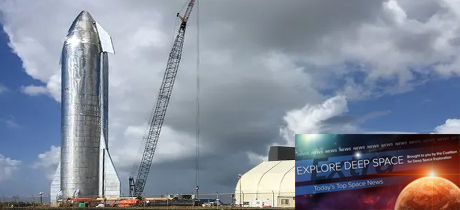EDITOR’S NOTE: CDSE is updating our mail distribution and the layout of Deep Space Extra beginning on Thursday of this week (April 30). If you are subscribed but do not receive Thursday’s edition, please check your SPAM or JUNK folders and ensure that CSE@griffincg.com is white listed. We hope you enjoy our new look!
In Today’s Deep Space Extra… If controversial, seeking space resources and using them to support exploration is a concept that is not that new. More insight into dealing with isolation from the astronauts. NASA and the European Space Agency (ESA) mature plans to collect samples from the Martian surface for return to Earth.
Human Space Flight
Astronaut Jessica Meir returns home to a “completely different planet”
Vanity Fair (4/27): NASA astronaut Jessica Meir shares her impressions of life on Earth as well as in space after descending from orbit on April 17 after a 205 day mission to the International Space Station (ISS), that included participation in the first three all women spacewalks. Because of the coronavirus threat that emerged after her September 25, 2019 launch, Meir returned home to a quarantine before she was able to fully reunite with family. “I was actually quite surprised by how soft of a landing it was. The strange part was, the hatch opens and there are these rescue teams there, all wearing masks and suddenly we’re part of this brave new world of COVID-19,”said Meir.
What my spacewalk taught me about isolation
New York Times (4/27): Retired NASA astronaut, aeronautical engineer and artist Nicole Stott offers a video op-ed assessment of the isolation that many are experiencing in response to the coronavirus pandemic and based on her 91 day mission to the International Space Station (ISS) in 2009 that included a spacewalk. “Feel like you are drifting in space? I know what that is like,” said Stott.
Putting the White House executive order on space resources in an international context
The Space Review (4/27): Despite some controversy, the executive order signed by President Trump on April 6 endorsing plans to make resources obtained from the Moon and elsewhere in space a part of a future human exploration strategy is in line with prior thinking and consultations with other nations, according to an assessment from Ian A. Christensen and Christopher D. Johnson, both of the Secure World Foundation.
Space Science
Taking on the challenge of Mars sample return
The Space Review (4/27): A complex follow on to NASA’s Mars 2020 Perseverance Rover mission would return samples of surface material gathered from Mars to Earth in the 2031 time frame. Perseverance is to launch between July 17 and August 5, reaching Jezero Crater on Mars in February 2021 to gather and cache samples. The follow on, a joint NASA/European Space Agency (ESA) mission, would launch in 2026 with a Mars lander, sample fetch rover and ascent vehicle to gather the Perseverance samples and lift them to orbit around Mars, where a ESA orbiter/NASA capture device would lock on and return the materials to Earth.
This is the final picture from NASA’s Spitzer Space Telescope
Universe Today (4/25): The Spitzer Space Telescope, one of NASA’s four great observatories, was retired January 30th, following 16 years of operations. Its last target was the California Nebula, which is about 1,000 light years from Earth. Spitzer revealed fine dust and gas in multiple wave lengths, revealing features otherwise not visible.
Op Eds
Get out of the way: The 1st restartable solid rocket fuel could help reduce space junk
Space.com (4/27): At the Los Alamos National Laboratory, experts have developed a solid rocket fuel concept, one that can be ignited and stopped multiple times in a fashion that could be used to deorbit end of life satellites to reign in the rising threat from orbital debris.
Other News
A big asteroid will fly by Earth Wednesday, but don’t panic. It won’t hit us
Space.com (4/27): There’s no threat of an impact. Early Wednesday, 1998 OR2, an asteroid measured at 1 1/2 miles wide will pass within 3.9 million miles of the Earth.
Starship chilled. Starship pressurized. And for the first time, it didn’t explode
Ars Technica (4/27): SpaceX’s Starship SN4 prototype passed a pressurization test Monday, one that had destroyed three previous versions in recent months, at the test site in South Texas. The test was conducted with liquid nitrogen as a stand-in for actual cryogenic rocket propellants. Static fire and a low altitude “hop” tests are anticipated following rocket engine installation.

